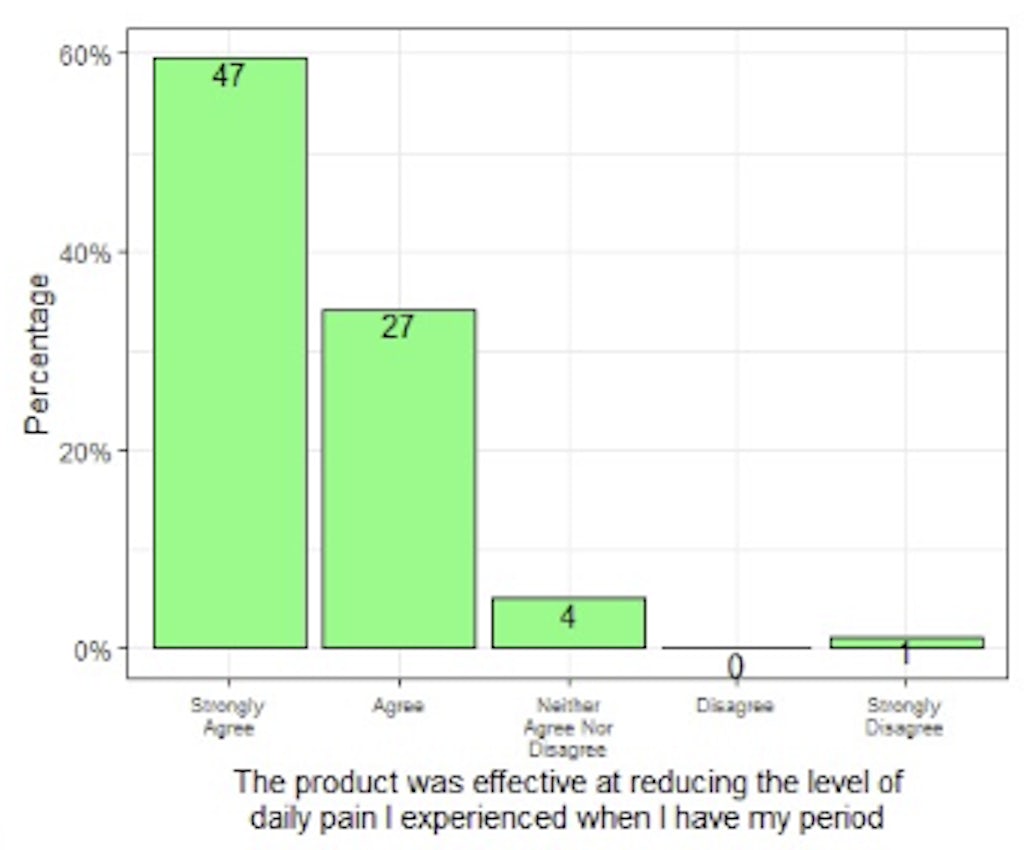
[ad_1]
Can cannabis suppositories ease period pain? Real world data says yes. (Photo by DESIGNECOLOGIST on Unsplash)
Cannabis suppositories haven’t (yet) made it to the spotlight. Most of the older research, dating back to the 1980s and 1990s, suggested very little bioavailability (i.e. absorption), at least with rectal insertion. But newer research, including from this year, has indicated that cannabinoid suppositories do have clinical utility, and real-world data collected recently from Cannigma users shows that a CBD product based on a full extract cannabis oil (FECO) can significantly improve menstrual symptoms. 1 2
Last month, we invited 100 women to try the YoniEase CBD suppository and asked them to share their experiences. The data was collected during an 8-week engagement in collaboration with MoreBetter, and the results all point in the same direction — less overall menstrual distress, better mood, and more manageable cramps.
“These YoniEase Whole Plant CBD suppositories are a fantastic remedy for my menstrual symptoms including mood swings, vaginal cramps, lower pelvic, abdominal cramps, and insomnia. The week I had my cycle was so much more tolerable with the use of these suppositories. My symptoms were eased quickly. I highly recommend,” one participant said, in a representative example of a flood of notably positive feedback at the end of the engagement.
Trusted Canna Nurse’s founder Megan Mbgengue already had plenty of patient reports indicating that the suppository was working to ease serious menstrual pain (along with other conditions and symptoms). Still, she wanted solid data backing the product before moving into mass production. And she got what she was looking for! Here’s what we learned about the product from this real-world data (RWD) project.
CBD suppository improves pain scores by 55%
Reducing pain levels tends to have broad positive effects on overall quality of life, so we looked at both to assess the effectiveness of the YoniEase suppository. We also used an internationally recognized scale, the MEDI-Q Menstrual Distress Questionnaire, to help contextualize the results. The MEDI-Q model evaluates menstruation-related distress and provides a representative score of stress perception.
While this RWD collection effort did not include a control group, the primary findings were statistically significant. This suggests that the results were not merely due to chance, but rather that people really felt a change while using the product. By the last day of product use in the trial phase, the average MEDI-Q score had dropped by 36%, and participants reported a 54% improvement in pain interfering with daily activities. Coupled with that, when asked at the end of the engagement whether the product was effective at reducing pain — which of course can be difficult to gauge — a whopping 93% agreed.

“This product far surpassed my expectations. As someone who lives with chronic pelvic pain, I experienced near total relief from my symptoms and look forward to integrating YoniEase into my pain management arsenal,” one satisfied product tester wrote.
I am incredibly impressed at how manageable my back pain, cramps, and body aches became after using Yoniease. I was finally able to do all the things instead of curling up on my couch for 4 days,” said another.
Zooming in on period-specific pain, the data indicated that the suppository was most effective in treating cramps, while it had less of an impact on symptoms like menstrual headache or nausea. The product trial period showed a 60% improvement in cramp severity over the week, and on a day-by-day basis, almost 88% felt it had improved their cramps the previous day.
Interestingly, some respondents (37%) noticed an improvement in focus and concentration while using the suppository — perhaps a byproduct of less pain, better sleep, and overall good mood.
This feedback summed it up succinctly: “It was absolutely amazing. Less pain, better mood, and even a shorter period.”
The MEDI-Q also looks at the relationship between pain and mood, and again, the data showed a 39% improvement throughout the product trial period, with the average score on a scale of 0 to 10 rising from 4.81 to 6.69 over the course of the week. And summarizing the entire experience, 82% of participants reported being in a better mood while using the CBD suppository.

Closely tied to mood, almost 85% of participants said that the product improved their overall quality of life, which again tracks with the improvement in the MEDI-Q results.
How to use the YoniEase CBD suppository
Along with getting a sense of how CBD suppositories can help ease menstrual symptoms, the data collected during this effort highlighted the best way to use YoniEase.
As mentioned, the participant experience was overwhelmingly positive, with 78% assessing that it was the best product for menstrual symptoms they’ve tried and 93% saying they would recommend it to others.
“This product should be promoted at a high level. I felt instant relief and it lasted all day. I would buy and recommend to all women,” one respondent reported at the end of the engagement.
One of the most common questions people considering using cannabinoid-based therapies ask is — will it get me high? For the vast majority of participants in this data collection effort, the product was not intoxicating. Those who reported feeling intoxicated almost exclusively had positive systemic effects and negative experiences were very rare. That is to say — they felt a bit odd but in a good way.
Getting down to the practical, here’s what we found from the data:
- The suppository can be inserted as needed, with most using it for the first three days of the menstrual cycle
- Suppositories used per day ranged from one to five, but the vast majority of participants were only using one per day
- Most participants inserted the suppository in the morning,
- Nine out of 10 times participants used the suppository vaginally (though some used it rectally)
- The majority of participants felt relief in under an hour, and often reported long-lasting effects – for up to four hours.
- The suppository can be (and often is) used in conjunction with other pain-relief strategies, including other cannabis products.
This remark from another participant gave a detailed review: “I have extremely terrible cramps for at least 3 to 4 days on my period. The YoniEase CBD Suppositories were easy to insert (I tried them rectally, since I bleed so bad I have to wear tampons and use pads) and it didn’t take long to notice the difference in the pain severity of my cramps. Within a half hour I noticed a big difference, especially by the second day. They have helped me better than anything else I’ve tried. I will definitely be buying these & recommending them to anyone I know who could benefit from them.”
This data shows that if you suffer from period pain, YoniEase is worth trying
As with all cannabis products — and any treatment, really — effects are individual, so you’ll need to try it to see if it works for you. While all of the data cited in this report is statistically significant, it differs from clinical research in that there is no control group or placebo. In other words, there’s no way to separate causation and correlation, and to tell if the results are directly related to the product in question, or simply the fact that people started taking this product with the intent of feeling better, so their pain reports improved after taking it.
To control for the lack of a placebo, we put some checks and balances in place. Participants answered questions for a full menstrual cycle without the product to establish a baseline assessment. But, as anyone who’s experienced menstural periods would know, symptoms can vary from month to month — so this research effort is still only a snapshot of a larger picture of a woman’s health. Still, analyzing the RWD collected over these two months indicated that this product is worth trying for those dealing with period pain, and to do that Trusted Canna Nurse has an exclusive offer for Cannigma readers — buy one pack of YoniEase suppositories and get a tin of THCV mints half off.
Sources
- Perlin, E., Smith, C. G., Nichols, A. I., Almirez, R., Flora, K. P., Cradock, J. C., & Peck, C. C. (1985). Disposition and bioavailability of various formulations of tetrahydrocannabinol in the rhesus monkey. Journal of pharmaceutical sciences, 74(2), 171–174. https://doi.org/10.1002/jps.2600740213
- Tarlovski, S., Bar Kadmon, A., Goldberg, E., Segal, D., Gavish, D., & Stepensky, D. (2024). Comparative Pharmacokinetic Assessment of Innovative Sublingual, Rectal and Vaporizer Cannabis Products Versus Approved Cannabis Products in Healthy Volunteers. Cannabis and cannabinoid research, 10.1089/can.2023.0229. Advance online publication. https://doi.org/10.1089/can.2023.0229
Thanks for your feedback!
Sign up for bi-weekly updates, packed full of cannabis education, recipes, and tips. Your inbox will love it.
[ad_2]
Source link